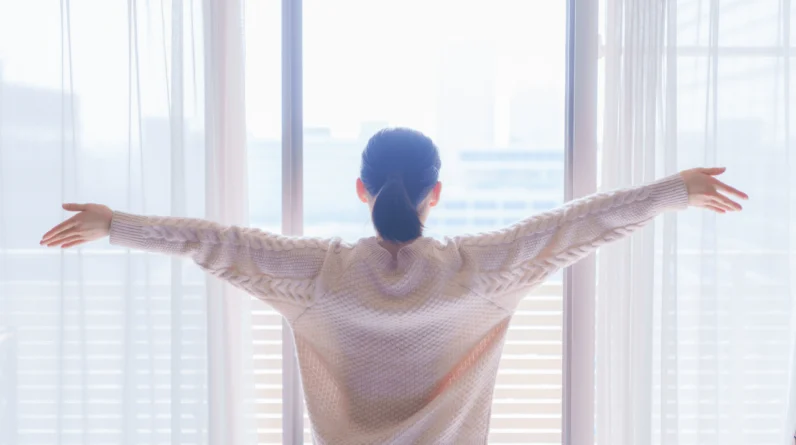
Struggling to fall asleep and stay asleep is one of the most frustrating situations. Maybe you have to get up early for work or perhaps it’s a big day tomorrow and you want to feel your best. But you’ve got one problem: You can’t fall asleep—and the more you try, the harder it seems to get.
Well, maybe you’ve finally found your answer; Sleep meditation can help prepare your body and mind for a restful night. It can help you relax, forgetting the worries and stressors of the day and allowing your mind to just let go. Arguably, nothing feels better than a good night’s rest!
So, how can you perform a sleep meditation? What should you know? Do sleep meditations actually work? In this article, we’re going to lay it all out, as well as offer up a step-by-step sleep meditation to help you get to sleep when you need to.
Are Sleep Meditations Good?
The Sleep Foundation claims that meditation can promote sleep by reducing pain and stress—two common factors that get in the way of most people’s ability to obtain that peaceful slumber. And research actually proves this.
Studies show how meditation actually reduces pain activity in the thalamus, ultimately, changing your perception of pain and stress. Pretty cool, right? But wait, there’s more…
Benefits of Sleep Meditation
Sleep meditation has various benefits, including reducing stress and enhancing overall well-being. It can decrease your risk of anxiety and depression, as well as even help you adjust to jetlag or a new sleep schedule.
In fact, researchers indicate that meditation (even just 10-30 minutes each day) can help improve sleep quality in adults. And who doesn’t want to get on board with that?
Plus, if we really stretch our reach here, sleep meditation can help you be more alert, have better concentration abilities, be able to problem-solve better, and so much more. Generally, you just think better and more clearly when you’ve had a goodnight’s rest (I think we can all relate here!).
Related Article: Here Are 5 Helpful Ways You Can Recover From Another Sleepless Night
How Long Should a Sleep Meditation Be?
If the idea of adding another thing to your to-do list is stressing you out, this will put your mind at ease: A sleep meditation only has to be a couple of minutes.
You can do about two to five minutes and notice vast improvements in your sleep. As time goes on and meditation becomes easier, you may want to slowly ramp up your meditation time to 15 to 20 minutes.
Basically, find what works for you, your schedule, and your stress levels. A couple of minutes is just fine and works just as well.
Now, let’s get into it. What do you need to do to perform a sleep meditation?
Your Step-By-Step Sleep Meditation
Step 1: Find a relaxing and comfortable position lying down in your bed.
Basically, tuck yourself in! Get into your PJs (or go for the full Monty if that’s you’re go-to for bed!). Get comfy. If you need more blankets, now is the time to grab them. Turn off your lights and act as if you’re going to sleep (because you are, but first you’re doing a meditation to help you ease into it!).
Step 2: Put on a relaxing background sound.
This is completely optional. Yet, some people find certain background music, such as rain sound, waves, or white noise, can help them fall asleep faster. This can also help block out any noise from the streets or the other rooms in your home.
Step 3: Take a few deep breaths.
Breath in through your nose and out through your mouth. Take full, deep belly breaths, pausing once you’ve taken a deep inhale and pausing once you’ve fully released via your exhale. Do this about 5-10 times to get started.
Step 4: Close your eyes.
Alright, now it’s time to get into it. You actually have a few options here. You can continue to practice deep breathing, focusing on your breath and letting any thought that comes to you simply pass by.
Alternatively, you can:
- Use progressive relaxation – This involves clenching each area of your body, then completely relaxing it. Sometimes, we don’t even notice how much tension we’re holding until we perform this contrast. In turn, this can help you melt into relaxation mode (and sleep!).
- Try visualization – Picture a place that you find peaceful. Try soaking up all the senses you possibly can. What do you feel? What do you smell? What are you hearing?
- Practice gratitude – List the things you’re grateful for and strive to truly feel that appreciation in your life. This is often referred to as “loving-kindness” meditation. Show yourself some love and kindness, then send that to someone else as you float away into dreamland.
- Count – This is ultra-simple. All you need to do is start at 10 and count backward. Once you reach 1, start again. Come morning, you won’t even know which number you fell asleep during.
- Do a body scan – This involves mindfully bringing your attention to each part of your body and noticing any tension that you are holding, then simply letting it go.
Related Article: 18 Tips For Better Sleep
Nothing Beats a Goodnight’s Sleep
The Dalai Lama once said, “Sleep is the best meditation.”
Thus, if you can get to sleep and stay asleep, you’re basically already an expert in the meditation field. These practices above can truly help you get the relaxation and rest you deserve. After all, there really is no replacement for sleep (or none that we know of!).
So, experiment with sleep meditation! Can you fall asleep faster and easier?
Read Next: 10 Ways to Help You Fall Asleep After Waking Up At Night
Photo by Craig Adderley







